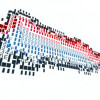CERN Battling Severe Case of Data Indigestion
Tony Cass, the leader of the European Organization for Nuclear Research's (CERN's) database services group, outlined some of the challenges the organization's computer system faces during his keynote speech Wednesday at LISA, the 24th Large Installation System Administration Conference, being held in San Jose, Calif., through Friday.
Smashing beams of protons and ions together at high speeds in CERN's Large Hadron Collider generates staggering amounts of data that requires a sophisticated computer system to handle. The CERN computing system has to winnow out a few hundred good events from the 40 million events generated every second by the particle collisions, store the data and analyze it, manage and control the high-energy beams used and send and receive gigabytes of data every day.
The accelerator generates 40 million particle collisions, or events, every second. CERN's computers pick out a "few hundred" per second of these that are good, then begins processing the data, Cass said. These good events are recorded on disks and magnetic tapes at 100 to 150 Mbps (megabits per second). That comes up to 15 petabytes of data a year for all four CERN detectors -- Alice, Atlas, CMS and LHCb. The data is transferred at 2 Gbps (gigabits per second) and CERN requires three full Oracle (Nasdaq: ORCL) SL8500 tape robots a year.









































































